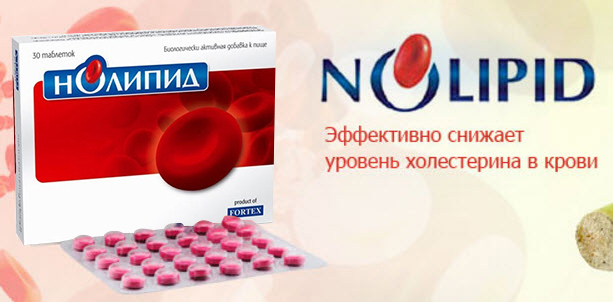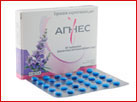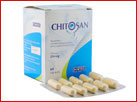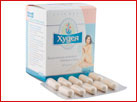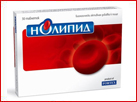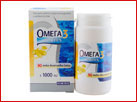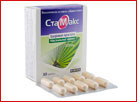Policosanol - A Better Alternative to Statin Drugs
New study finds that this sugar-cane extract safely lowers cholesterol levels
By Aaron W. Jensen, Ph.D.
Let's say that you have the choice between taking a prescription drug and a natural supplement to help you lower your cholesterol levels. And let's say there really isn't much difference in how these two approaches affect total cholesterol in the blood - they both lower the levels significantly. Which approach to better heart health would you choose? If you're like most Americans, you would choose the natural approach. A report released by ConsumerLab.com, an independent laboratory that evaluates nutritional supplements, claims that the reason most supplement users elect nutritional supplements over pharmaceutical drugs is fear of side effects from the latter.1 Simply stated, consumers tend to associate prescription drugs with more frequent and more pronounced side effects, so they choose nutritional supplements instead. With respect to cholesterol-lowering drugs, their fears seem to be well-founded, as evidenced by the recent removal from the market of the statin drug cerivastatin (Baycol®) because of severe side effects that led to death in over 30 individuals, mainly from rhabdomyolysis.* A recent analysis of the association of this disease with the use of statin drugs, from reports to the FDA during the period November 1997 to March 2000, found 601 substantiated cases.2 Each of the six statins on the market - atorvastatin, cerivastatin, fluvastatin, lovastatin, pravastatin, and simvastatin - had cases associated with its use. The highest frequencies occurred with cerivastatin and simvastatin, and the lowest with fluvastatin.
*Rhabdomyolysis is a muscle-wasting disease in which muscle cells break down very quickly, producing so much metabolic waste as to overwhelm the kidneys. In extreme cases, this condition may result in kidney failure and even death. Most, but not all, of the deaths attributed to Baycol resulted from a combination therapy that employed another cholesterol-lowering drug, gemfibrozil (Lopid®).
Policosanol - The Natural Choice
All things considered, most people would probably prefer a natural supplement (with virtually no side effects) for reducing their cholesterol levels. Does such a supplement exist? Indeed it does, although you may not have heard of it, because pharmaceutical firms have been flooding the popular press with information about the statin drugs. Here, however, you can learn about the best available natural product to protect against high cholesterol: policosanol. Policosanol is a mixture of related chemical compounds isolated from sugar cane (Saccharum officinarum L.). The compounds that constitute policosanol are not sugars, however, and they do not raise blood sugar levels. What they do is inhibit the body's synthesis of cholesterol, which occurs in the liver, thus effectively lowering blood cholesterol levels. In patients with high levels, the effects can be dramatic, as we will see.
Policosanol inhibits the body's synthesis of cholesterol, which occurs in the liver, thus effectively lowering blood cholesterol levels. A study recently published in the American Heart Journal concluded that "policosanol is a very promising phytochemical alternative to classic lipid-lowering agents such as the statins."3 (Phytochemicals are chemicals derived from plants; lipids are fatty chemicals such as cholesterol and, of course, fats.) The German authors of this study systematically reviewed all the research literature on policosanol and concluded that it performed as well as or better than a variety of statin drugs to lower LDL-cholesterol when used in randomized, placebo-controlled, double-blind clinical trials. (See the sidebar "The Bad and Good Cholesterols" for an explanation of LDL and HDL cholesterols.) The Bad and Good Cholesterols In our bloodstream, cholesterol exists in two forms. One is "bad," in the sense that it can lead to the formation of atherosclerotic plaque in our arteries, especially when it becomes oxidized by free radicals. The other is "good," in the sense that it does not do this but is instead transported back to the liver for metabolism or excretion. LDL (low-density lipoprotein) cholesterol is the bad form - we want it to be lower. HDL (high-density lipoprotein) cholesterol is the good form - we want it to be higher. Thus, the ideal cholesterol treatment would lower our LDL level and "higher" our HDL level. When we lower our total cholesterol, the reduction occurs primarily in LDL, which is the predominant form. Cholesterol levels are expressed as mg/dL (milligrams per deciliter).
Policosanol Beats Statins in Head-to-Head Trials
Five clinical trials have been conducted to compare the efficacy of policosanol with that of three different statin drugs: simvastatin (one trial), lovastatin (two trials), and pravastatin (two trials). The trial that compared policosanol (10 mg/day) to simvastatin (10 mg/day) showed a similar decrease in LDL-cholesterol (LDL for short) with each treatment: 18% in the policosanol group versus 20% for the simvastatin group. All the other head-to-head trials showed that policosanol outperformed the statin drugs. For example, policosanol (10 mg/day) lowered LDL by 20-32% versus 17-28% for lovastatin (20 mg/day). Similarly, policosanol (10 mg/day) lowered LDL by 19-24% versus 16-20% for pravastatin (10 mg/day). It is noteworthy that four of the five head-to-head trials also resulted in a significant - and desirable - increase in HDL-cholesterol (HDL for short) in the policosanol group (by up to 14% in two of the trials), whereas only one of the three statins (pravastatin) increased HDL significantly (by 5.6%). In some of the policosanol trials, there was also a positive impact - a reduction - on blood triglyceride levels (triglycerides are fats); however, the variation from group to group in this regard made it difficult to determine the significance of the effect. Why Do the Results Vary? You may have noticed in the above discussion that there was much variation in the results obtained with policosanol. For example, even though 10 mg/day of policosanol was used throughout, the reductions in LDL ranged from 18% to 32%. Why the inconsistency? It is simply due to the nature of clinical trials. Even though all the subjects in these trials had high cholesterol levels (averaging between 173 and 206 mg/dL of LDL), the various group profiles in terms of age, gender, genetics, diet, exercise, and lifestyle were all different. All patients responded to the treatment in their own unique ways, and the average response of each group is reflected in the final data.
Policosanol outperformed the statin drugs. Four of the five head- to-head trials also resulted in a significant - and desirable - increase in HDL-cholesterol. In addition, the different trials enrolled patients with potentially compounding health conditions. One trial enrolled patients with diabetes, e.g., while another specifically enrolled elderly patients, and yet another focused on patients with multiple risk factors for heart disease. Thus, none of the five head-to-head trials had similar medical profiles. They did have one thing in common, however: the results. Policosanol performed as well as or better than statin drugs in all the trials.
Estimating the Risk of Heart Disease A recent article in The Journal of the American Medical Association includes a worksheet - called the Framingham Point Scores - designed to assess the 10-year risk of heart disease in both men and women.1 While the worksheet is too complex to replicate here, the main features are worth noting. The risk of heart disease rises dramatically as you age, especially if you are male (women begin to catch up with men in this regard only after menopause). You can't help what sex you are (OK, you can, but it's awfully expensive, and it would annoy your kids), nor can you stop growing older - but you can retard the aging process. That means taking control of some of the other risk factors for heart disease, including high cholesterol, high blood pressure, and smoking. If you lower the first two and kick the last, you stand a much better chance of avoiding heart disease. And don't forget regular exercise, the closest thing there is to a panacea. The primary risk factor for heart disease is high cholesterol. It has been estimated that a decrease of 12-38% in LDL-cholesterol correlates to a risk reduction of 19-35% (roughly a 1% decrease in risk for each 1% decrease in LDL).2 In addition, increasing HDL-cholesterol levels is beneficial: a 1-mg/dL increase (roughly a 2-3% increase) corresponds to a 2-4% risk reduction (again, about a 1% decrease in risk for each 1% increase in HDL).3 These estimates clearly underscore the importance of improving blood cholesterol levels - a very attainable goal - in order to decrease the risk of heart disease. References 1. Expert Panel on Detection, Evaluation, and Treatment of High Blood Cholesterol in Adults. Executive summary of the third report of the National Cholesterol Education Program (NCEP) Expert Panel on Detection, Evaluation, and Treatment of High Blood Cholesterol in Adults (Adult Treatment Panel III). J Am Med Assoc 2001;285:2486-97. 2. The Long-Term Intervention with Pravastatin in Ischaemic Disease (LIPID) Study Group. Prevention of cardiovascular events and death with pravastatin in patients with coronary heart disease and a broad range of initial cholesterol levels. N Engl J Med 1998;339:1349-57. 3. Gordon DJ, Probstfield JL, Garrison RJ, et al. High-density lipoprotein cholesterol and cardiovascular disease: four prospective American studies. Circulation 1989;79:8-15.
Policosanol Is Effective in a Wide Range of People As the above data from the head-to-head trials suggest, policosanol is effective in a wide range of patient populations. Additional studies - not head-to-head trials against statin drugs, but randomized, double-blind, placebo-controlled trials that evaluated policosanol on its own merits - demonstrated that not only is policosanol beneficial for patients with diabetes and for the elderly, but it can effectively lower cholesterol levels in postmenopausal women, in patients with liver dysfunction, and in individuals with high blood pressure and other risk factors for heart disease. This additional set of trials - seven in all - revealed similar improvements in blood lipid profiles in patients with special health concerns. Overall, these varied patient groups registered decreases in LDL of 18-44%, while total cholesterol decreased by 13-29%. In general, there were also increases in HDL, ranging from a modest 6% to a dramatic 29%. Policosanol Works Over the Long Term The five head-to-head trials reviewed in this study were fairly short in duration - generally 4 to 8 weeks - so naturally one wonders whether policosanol is effective in reducing blood cholesterol over the long term. A number of placebo-controlled, double-blind clinical trials have been performed to answer this question, and the answer is a resounding yes. Three studies ran for one year or longer (with a total enrollment of 225 patients with high cholesterol), and all showed that policosanol remained effective for the duration. Two of the trials ran for exactly one year but differed in the amount of policosanol used. The first trial (1994) used a single dose of 5 mg/day and registered a decrease of 23.7% in LDL, with a slight increase (2.2%) in HDL. The second trial, a year later, used 10 mg/day (5 mg twice daily) and gave better results: a decrease of 27.5% in LDL and an increase of 25.9% in HDL. The third study, also published in 1995, followed 69 patients who were given 5 mg of policosanol twice a day for 2 years. The patients had an average starting value for LDL of 207 mg/dL. At the end of the study period, their levels had fallen by nearly a quarter (24.8%), with readings consistently below 160 mg/dL. The increase in HDL during the study period was 11.2%. Clearly, policosanol is effective over the long term. The fact that the values recorded for LDL in these studies were consistently lower than those in the much shorter studies discussed earlier suggests that in order to derive the greatest benefit from policosanol, it should be taken for extended periods of time.
Policosanol Is Not Only Effective, but Safe Too
To date, the efficacy and safety of natural policosanol have been documented in over 60 clinical trials involving over 3000 subjects. Long-term administration of policosanol has been found to be well tolerated, and adverse events have been rare (the most common side effect is weight loss, which occurs in about 1.8% of the subjects). The currently recommended amount of policosanol to begin with is 5 mg/day, taken with the evening meal. This can be increased to 10-20 mg/day (preferably in divided amounts at meal times), depending on the results.
Cholesterol guidelines from the National Cholesterol Education Program Expert Panel4
Total Cholesterol (LDL and HDL)*
Desirable Less than 200 mg/dL
Borderline high 200-239 mg/dL
High 240 mg/dL or greater
LDL
Optimal Less than 100 mg/dL
Above optimal 100-129 mg/dL
Borderline high 130-159 mg/dL
High 160-189 mg/dL
Very high 190 mg/dL or greater
HDL
Desirable 35 mg/dL or greater
Undesirable Less than 35 mg/dL
Ratio of Total Cholesterol to HDL
Desirable Less than 3.0
Undesirable 3.0 or greater
*These levels should be even lower if you have heart disease.
Policosanol Is Heart-Healthy Cardiovascular disease is still the leading cause of death in the United States, for both men and women. Because high cholesterol is the greatest risk factor, it makes sense to lower cholesterol levels to help maintain good heart health. To achieve this goal, the National Cholesterol Education Program (NCEP) recommends a combination of lifestyle modifications, including reduced intake of saturated fats and cholesterol, increased dietary fiber, weight reduction, and increased physical exercise.4 While these guidelines are helpful - even life-saving - to some, not everyone is able to implement them successfully. Consequently, lipid-lowering therapy is a useful approach for many individuals. As we've demonstrated here, policosanol is an especially effective natural agent that lowers blood cholesterol levels.
References
1. PR Newswire, March 5, 2002. White Plains, NY.
2. Omar MA, Wilson JP. FDA adverse event reports on statin-associated rhabdomyolysis. Ann Pharmacother 2002
Feb;36(2):288-95.
3. Gouni-Berthold I, Berthold HK. Policosanol: clinical pharmacology and therapeutic significance of a new lipid-lowering
agent. Am Heart J 2002;143:356-65.
4. Expert Panel on Detection, Evaluation, and Treatment of High Blood Cholesterol in Adults. Executive summary of the third
report of the National Cholesterol Education Program (NCEP) Expert Panel on Detection, Evaluation, and Treatment of High
Blood Cholesterol in Adults (Adult Treatment Panel III). J Am Med Assoc 2001;285:2486-97.
